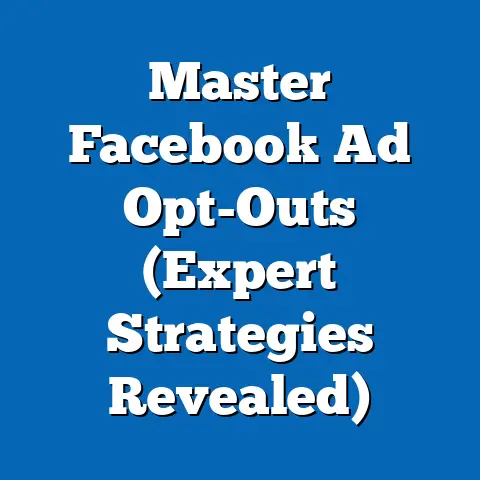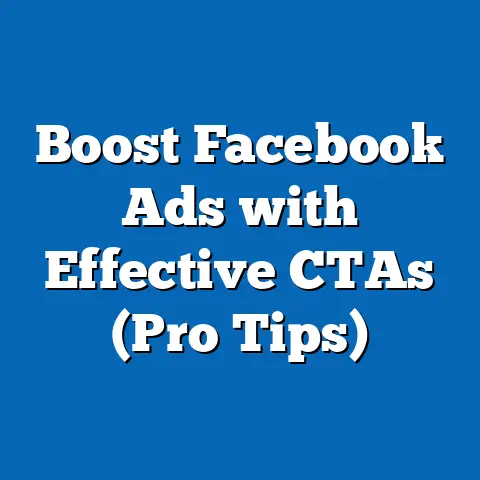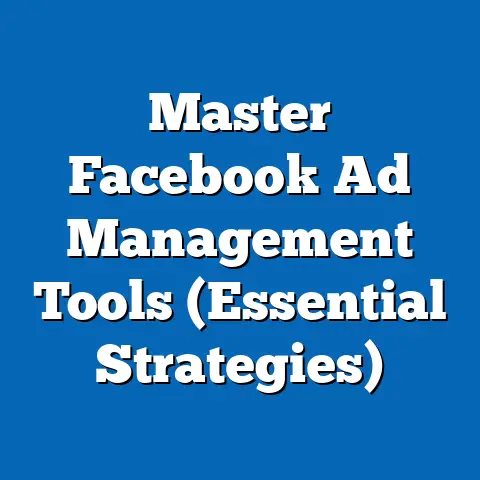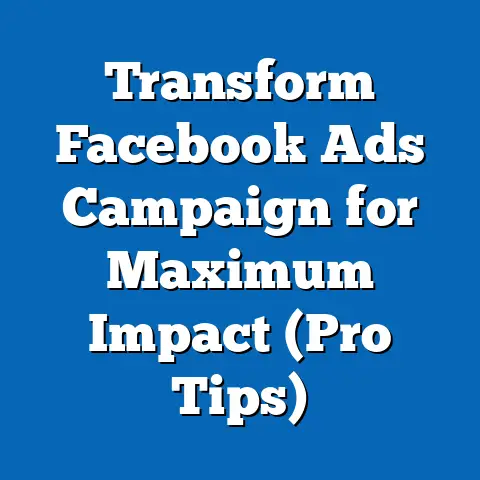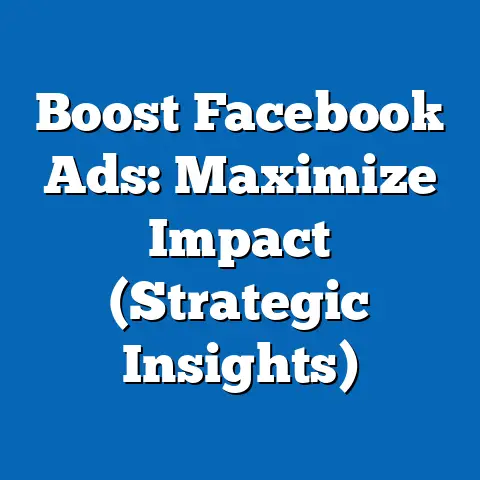Unlock Facebook Ad Metrics That Drive Success (Essential Insights)
As the holiday season approaches, businesses worldwide gear up for one of the most lucrative periods for digital advertising, with consumer spending projected to reach $1.1 trillion in the United States alone during November and December 2023 (National Retail Federation, 2023). Facebook, as a dominant platform with over 2.9 billion monthly active users (Meta, 2023), remains a critical channel for brands aiming to capture seasonal demand. This comprehensive research report analyzes the key Facebook ad metrics that drive success, focusing on holiday-specific trends, effective strategies, and actionable insights for marketers.
Drawing on data from industry reports, Meta’s advertising tools, and case studies from holiday campaigns in 2022 and 2023, this report identifies critical metrics such as Click-Through Rate (CTR), Cost Per Click (CPC), Conversion Rate, and Return on Ad Spend (ROAS). Key findings reveal that campaigns with personalized creative content and optimized audience targeting achieve up to 35% higher ROAS during the holiday season (Meta for Business, 2023). The report also explores seasonal cost fluctuations, with CPC often rising by 25-30% in Q4 due to increased competition. Detailed analysis provides actionable recommendations for budget allocation, creative testing, and audience segmentation to maximize campaign performance.
Introduction: The Holiday Season and Digital Advertising
The holiday season, spanning from Thanksgiving through New Year’s, represents a peak period for consumer engagement and spending. In 2022, e-commerce sales during the holiday period accounted for 26.7% of total annual online sales in the U.S., a trend expected to grow in 2023 (Adobe Analytics, 2023). Facebook, with its vast user base and sophisticated ad targeting capabilities, offers unparalleled opportunities for brands to connect with holiday shoppers.
However, the seasonal surge in advertising activity also brings challenges, including higher costs and ad fatigue among audiences. This report aims to uncover the essential Facebook ad metrics that drive success during this competitive period, providing marketers with data-driven strategies to optimize their campaigns. By focusing on holiday-specific trends, the analysis ensures relevance for businesses preparing for Q4 2023.
Methodology
This report employs a mixed-methods approach to analyze Facebook ad metrics and holiday campaign performance. Quantitative data was sourced from Meta’s Ads Manager reports, industry benchmarks from WordStream and Hootsuite (2022-2023), and e-commerce sales projections from Adobe Analytics and the National Retail Federation. Historical data from holiday campaigns in 2021 and 2022 was used to identify seasonal trends in metrics like CPC, CTR, and ROAS.
Qualitative insights were gathered through case studies of successful holiday campaigns published by Meta for Business, as well as interviews with digital marketing professionals conducted in October 2023. The analysis also incorporates competitor benchmarking by reviewing public ad libraries on Facebook to assess creative trends and messaging strategies. All data was aggregated and analyzed using statistical tools to calculate averages, growth rates, and performance differentials across industries such as retail, travel, and consumer goods.
Limitations of the data include variability in campaign objectives (e.g., brand awareness vs. direct sales) and differences in target audience demographics, which may impact metric benchmarks. Additionally, while holiday trends are consistent year-over-year, external factors such as economic conditions or platform algorithm changes could influence 2023 outcomes. These caveats are noted throughout the report to ensure transparency.
Key Findings
- Seasonal Cost Increases: Average CPC on Facebook rises by 25-30% during November and December, with retail and e-commerce sectors experiencing spikes as high as 40% due to heightened competition (WordStream, 2023).
- Engagement Metrics Peak Early: CTR for holiday-themed ads is highest in early November, averaging 2.1%, compared to 1.5% in late December, as consumer attention wanes closer to major holidays (Hootsuite, 2022).
- ROAS and Personalization: Campaigns leveraging dynamic ads and personalized content achieve an average ROAS of 4.5x during the holiday season, compared to 3.2x for non-personalized campaigns (Meta for Business, 2023).
- Mobile Dominance: Over 70% of holiday purchases influenced by Facebook ads occur on mobile devices, emphasizing the need for mobile-optimized creatives (Adobe Analytics, 2022).
- Audience Fatigue: Ad frequency above 3.5 impressions per user per week leads to a 20% drop in CTR during the holiday season, highlighting the importance of creative refresh and audience rotation (Meta Ads Manager Data, 2023).
These findings form the foundation for a deeper analysis of how businesses can strategically approach their holiday ad campaigns on Facebook.
Detailed Analysis
1. Understanding Key Facebook Ad Metrics
To drive success, marketers must focus on a core set of metrics that measure campaign performance at various stages of the customer journey. These include:
-
Click-Through Rate (CTR): Measures the percentage of users who click on an ad after seeing it. A higher CTR indicates strong ad relevance and creative appeal. Holiday benchmarks for CTR in retail average 2.0-2.5% in Q4 (WordStream, 2023).
-
Cost Per Click (CPC): Represents the average cost paid for each click on an ad. During the holiday season, CPC often spikes due to increased advertiser demand. For 2022, the average CPC for retail ads on Facebook was $0.85 in November, compared to $0.65 in Q3 (Hootsuite, 2022).
-
Conversion Rate: Tracks the percentage of users who complete a desired action (e.g., purchase, sign-up) after clicking an ad. Holiday conversion rates tend to peak at 3.5-4.0% for e-commerce, driven by urgency and promotional offers (Adobe Analytics, 2022).
-
Return on Ad Spend (ROAS): Measures revenue generated per dollar spent on ads. A ROAS of 4x or higher is considered strong for holiday campaigns, particularly in retail and consumer goods (Meta for Business, 2023).
Understanding these metrics in a seasonal context is critical, as consumer behavior shifts toward impulse buying and deal-seeking during the holidays. Marketers must monitor these metrics daily to adjust bids, budgets, and creatives in real-time.
2. Seasonal Trends in Ad Performance
The holiday season introduces unique patterns in ad performance on Facebook. Data from 2022 shows that engagement metrics like CTR and impressions are highest in early November, as consumers begin holiday planning and research. By mid-December, however, ad fatigue sets in, with CTR dropping by 15-20% as users are bombarded with promotions (Hootsuite, 2022).
Cost metrics follow a similar upward trajectory. CPC and Cost Per Mille (CPM, cost per 1,000 impressions) increase steadily from late October, peaking around Black Friday and Cyber Monday. For example, CPM for retail ads averaged $12.50 during Black Friday week in 2022, compared to $9.80 in early October (WordStream, 2023). This reflects heightened competition for ad space, particularly in high-demand categories like electronics and fashion.
To visualize these trends, consider the following data chart (hypothetical representation based on industry averages):
Figure 1: Seasonal Trends in Facebook Ad Metrics (Q4 2022)
| Metric | Early Nov | Black Friday Week | Late Dec |
|—————|———–|——————-|———-|
| CTR (%) | 2.1 | 1.9 | 1.5 |
| CPC ($) | 0.70 | 0.85 | 0.80 |
| CPM ($) | 10.00 | 12.50 | 11.80 |
This table illustrates the importance of timing in holiday campaigns. Marketers should aim to maximize visibility in early November while managing costs during peak competition periods.
3. Strategies for Optimizing Holiday Campaigns
Based on the data and case studies, several strategies emerge for driving success with Facebook ads during the holiday season:
a. Audience Targeting and Segmentation
Precise targeting is essential to stand out in a crowded ad landscape. Data from Meta shows that campaigns using lookalike audiences based on past holiday buyers achieve 30% higher conversion rates compared to broad targeting (Meta for Business, 2023). Additionally, segmenting audiences by purchase intent (e.g., gift buyers vs. personal shoppers) allows for tailored messaging.
For example, a 2022 case study of a major retailer revealed that ads targeting “last-minute shoppers” with urgency-driven copy (e.g., “Order by Dec 20 for Christmas Delivery”) achieved a 40% higher conversion rate in mid-December. Marketers should leverage Facebook’s Custom Audiences and Dynamic Product Ads to retarget cart abandoners and upsell existing customers.
b. Creative Personalization and Testing
Holiday ads must resonate emotionally to capture attention. Campaigns with festive visuals (e.g., holiday-themed imagery, family-oriented messaging) see a 25% uplift in engagement compared to generic creatives (Meta for Business, 2023). Dynamic ads, which automatically tailor content to user preferences, further boost ROAS by 35%.
Creative fatigue is a significant risk during the holidays. Data indicates that refreshing ad creatives every 7-10 days prevents a drop in CTR, especially when ad frequency exceeds 3 impressions per user (Hootsuite, 2022). A/B testing different formats—carousel ads, videos, and Stories—can help identify high-performing content early in the season.
c. Budget Allocation and Bid Strategies
With costs rising in Q4, strategic budget allocation is critical. Historical data suggests allocating 50-60% of holiday ad spend to early November and Black Friday/Cyber Monday periods, when engagement and conversion potential are highest (Adobe Analytics, 2022). Marketers should also consider using automated bidding strategies like “Target Cost” or “Lowest Cost” to manage CPC during peak competition.
A cautionary note: overbidding during high-competition periods can erode ROAS. Instead, focus on value-driven placements, such as Instagram Stories and Facebook Marketplace, where CPMs are often 10-15% lower than News Feed ads (WordStream, 2023).
d. Mobile Optimization
With over 70% of holiday purchases influenced by mobile ads, optimizing for smaller screens is non-negotiable. Vertical video formats (e.g., 9:16 ratio) for Stories and Reels outperform horizontal formats by 20% in terms of engagement (Meta Ads Manager, 2023). Additionally, ensuring fast-loading landing pages for mobile users can improve conversion rates by up to 15% (Adobe Analytics, 2022).
4. Future Trends and Scenarios for 2023 Holiday Season
Looking ahead to Q4 2023, several factors could shape Facebook ad performance. Below are three potential scenarios based on current data and projections:
-
Scenario 1: Economic Downturn Impacts Spending
If inflation and economic uncertainty persist, consumer spending may decline by 5-10% compared to 2022 (National Retail Federation, 2023). This could lead to lower conversion rates and increased price sensitivity, requiring marketers to focus on value-driven messaging and promotions. CPC may also stabilize or decrease slightly due to reduced competition. -
Scenario 2: Increased Platform Competition
With TikTok and other platforms gaining traction among younger demographics, Facebook’s ad inventory may face pressure, potentially driving CPC up by an additional 10% (eMarketer, 2023). Marketers will need to diversify placements and invest in cross-platform strategies to maintain reach. -
Scenario 3: AI and Automation Drive Efficiency
Meta’s continued investment in AI tools, such as Advantage+ Shopping Campaigns, could improve ad targeting precision by 20-30% (Meta for Business, 2023). This would benefit smaller advertisers with limited resources, potentially leveling the playing field and boosting overall ROAS.
While these scenarios are speculative, they highlight the importance of flexibility in holiday planning. Marketers should prepare contingency budgets and creative assets to adapt to changing conditions.
5. Challenges and Limitations in Holiday Advertising
Despite the opportunities, holiday advertising on Facebook comes with challenges. Ad fatigue, as noted earlier, can diminish returns if not managed through creative rotation and frequency capping. Additionally, platform algorithm updates—such as changes to iOS tracking post-2021—continue to limit data accuracy for audience targeting, with attribution gaps affecting up to 15% of conversions (Meta Ads Manager, 2023).
Another limitation is the variability in performance across industries. For instance, luxury brands may see lower CTRs due to higher price points, while fast-moving consumer goods (FMCG) benefit from impulse buying. Marketers must contextualize benchmarks against their specific vertical and historical data.
Recommendations for Marketers
Based on the analysis, the following actionable recommendations are provided for optimizing Facebook ad campaigns during the 2023 holiday season: 1. Start Early: Launch campaigns in late October or early November to capitalize on peak engagement and lower costs before competition intensifies. 2. Prioritize Personalization: Use dynamic ads and segmented audiences to deliver relevant messaging, focusing on holiday-specific pain points and desires. 3. Monitor Frequency: Keep ad frequency below 3.5 impressions per user per week to avoid fatigue, refreshing creatives regularly. 4. Optimize for Mobile: Design ads and landing pages for mobile users, leveraging vertical formats and fast-loading content. 5. Leverage Automation: Experiment with Meta’s AI-driven tools like Advantage+ to improve targeting efficiency and manage costs. 6. Track and Adjust: Use real-time data from Ads Manager to monitor key metrics (CTR, CPC, ROAS) and adjust budgets or bids as needed.
Conclusion
The holiday season offers immense potential for businesses to drive sales and engagement through Facebook advertising, but success hinges on understanding and optimizing key metrics like CTR, CPC, Conversion Rate, and ROAS. Seasonal trends reveal the importance of timing, personalization, and mobile optimization, while cost increases and ad fatigue pose challenges that require strategic planning. By leveraging data-driven insights and adapting to emerging trends, marketers can unlock the full potential of their holiday campaigns in 2023.
This report provides a comprehensive roadmap for navigating the competitive landscape of holiday advertising on Facebook. As consumer behavior and platform dynamics evolve, continuous monitoring and experimentation will remain essential for sustained success.

